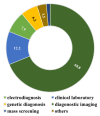Demystifying Supervised Learning in Healthcare 4.0: A New Reality of Transforming Diagnostic Medicine
- PMID: 36292238
- PMCID: PMC9601517
- DOI: 10.3390/diagnostics12102549
Demystifying Supervised Learning in Healthcare 4.0: A New Reality of Transforming Diagnostic Medicine
Abstract
The global healthcare sector continues to grow rapidly and is reflected as one of the fastest-growing sectors in the fourth industrial revolution (4.0). The majority of the healthcare industry still uses labor-intensive, time-consuming, and error-prone traditional, manual, and manpower-based methods. This review addresses the current paradigm, the potential for new scientific discoveries, the technological state of preparation, the potential for supervised machine learning (SML) prospects in various healthcare sectors, and ethical issues. The effectiveness and potential for innovation of disease diagnosis, personalized medicine, clinical trials, non-invasive image analysis, drug discovery, patient care services, remote patient monitoring, hospital data, and nanotechnology in various learning-based automation in healthcare along with the requirement for explainable artificial intelligence (AI) in healthcare are evaluated. In order to understand the potential architecture of non-invasive treatment, a thorough study of medical imaging analysis from a technical point of view is presented. This study also represents new thinking and developments that will push the boundaries and increase the opportunity for healthcare through AI and SML in the near future. Nowadays, SML-based applications require a lot of data quality awareness as healthcare is data-heavy, and knowledge management is paramount. Nowadays, SML in biomedical and healthcare developments needs skills, quality data consciousness for data-intensive study, and a knowledge-centric health management system. As a result, the merits, demerits, and precautions need to take ethics and the other effects of AI and SML into consideration. The overall insight in this paper will help researchers in academia and industry to understand and address the future research that needs to be discussed on SML in the healthcare and biomedical sectors.
Keywords: XAI; artificial intelligence; computer vision; deep learning; healthcare; medical imaging; precision medicine; supervised learning.
Conflict of interest statement
The authors have no conflict of interest to declare.
Figures










Similar articles
-
The future of Cochrane Neonatal.Early Hum Dev. 2020 Nov;150:105191. doi: 10.1016/j.earlhumdev.2020.105191. Epub 2020 Sep 12. Early Hum Dev. 2020. PMID: 33036834
-
The Beginning of a New Era: Artificial Intelligence in Healthcare.Adv Pharm Bull. 2021 May;11(3):414-425. doi: 10.34172/apb.2021.049. Epub 2020 Jul 15. Adv Pharm Bull. 2021. PMID: 34513616 Free PMC article. Review.
-
Artificial Intelligence Technologies in Cardiology.J Cardiovasc Dev Dis. 2023 May 6;10(5):202. doi: 10.3390/jcdd10050202. J Cardiovasc Dev Dis. 2023. PMID: 37233169 Free PMC article. Review.
-
Artificial Intelligence and Machine Learning in Pharmacological Research: Bridging the Gap Between Data and Drug Discovery.Cureus. 2023 Aug 30;15(8):e44359. doi: 10.7759/cureus.44359. eCollection 2023 Aug. Cureus. 2023. PMID: 37779744 Free PMC article. Review.
-
Integrating Artificial and Human Intelligence: A Partnership for Responsible Innovation in Biomedical Engineering and Medicine.OMICS. 2020 May;24(5):247-263. doi: 10.1089/omi.2019.0038. Epub 2019 Jul 16. OMICS. 2020. PMID: 31313972 Review.
Cited by
-
Applications of Machine Learning (ML) and Mathematical Modeling (MM) in Healthcare with Special Focus on Cancer Prognosis and Anticancer Therapy: Current Status and Challenges.Pharmaceutics. 2024 Feb 9;16(2):260. doi: 10.3390/pharmaceutics16020260. Pharmaceutics. 2024. PMID: 38399314 Free PMC article. Review.
-
Early Melanoma Detection Based on a Hybrid YOLOv5 and ResNet Technique.Diagnostics (Basel). 2023 Aug 30;13(17):2804. doi: 10.3390/diagnostics13172804. Diagnostics (Basel). 2023. PMID: 37685342 Free PMC article.
-
Transformative Potential of AI in Healthcare: Definitions, Applications, and Navigating the Ethical Landscape and Public Perspectives.Healthcare (Basel). 2024 Jan 5;12(2):125. doi: 10.3390/healthcare12020125. Healthcare (Basel). 2024. PMID: 38255014 Free PMC article. Review.
-
A novel approach to brain tumor detection using K-Means++, SGLDM, ResNet50, and synthetic data augmentation.Front Physiol. 2024 Jul 15;15:1342572. doi: 10.3389/fphys.2024.1342572. eCollection 2024. Front Physiol. 2024. PMID: 39077759 Free PMC article.
-
Hybrid Techniques of X-ray Analysis to Predict Knee Osteoarthritis Grades Based on Fusion Features of CNN and Handcrafted.Diagnostics (Basel). 2023 May 2;13(9):1609. doi: 10.3390/diagnostics13091609. Diagnostics (Basel). 2023. PMID: 37175000 Free PMC article.
References
-
- Aggarwal M., Madhukar M. Cloud Computing Systems and Applications in Healthcare. IGI Global; Hershey, PA, USA: 2016. IBM’s Watson analytics for health care: A miracle made true.
Publication types
LinkOut - more resources
Full Text Sources
Research Materials

